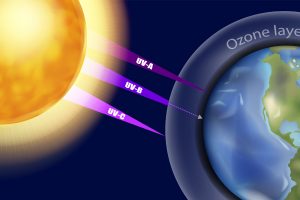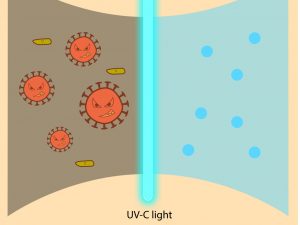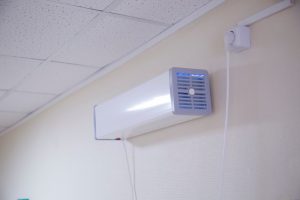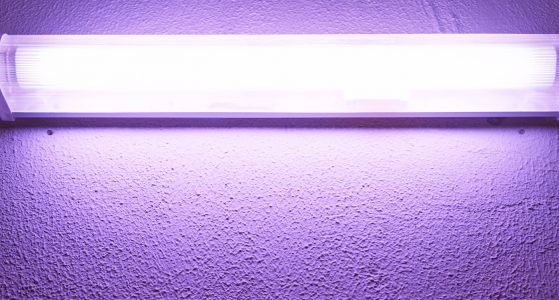LightSources and LightTech offer UVC germicidal lamps designed, engineered, and manufactured to emit the optimal UVC wavelength for effective disinfection.
What is UVC Wavelength?
Ultraviolet (UV) light is emitted by natural sunlight, measured in nanometers (nm), and divided into three main categories within UVA, UVB and UVC wavelengths. UV light comes from the sun or from man-made sources of UV lamps such as germicidal lamps or tanning bed lamps and may also come from welding torches. UV light is a form of electromagnetic radiation as radiation is the emission of energy from any source.
UV electromagnetic radiation is measured in wavelengths that are shorter than visible light, but longer than x-rays, measuring approximately 100 to 400 nm, with the following properties:
- UVA (315–400 nm) – Long wavelength UV light which is not significantly filtered out by the atmosphere allowing approximately 90% of UVA radiation to reach the Earth’s surface.
- UVB (280–315 nm) – Medium wavelength UVB light is mostly absorbed by the ozone layer in the atmosphere although about 10% of UVB radiation reaches the surface of the Earth.
- UVC (100–280 nm) – Shortwave UVC radiation is completely absorbed by the ozone layer although is replicated in specially designed UVC germicidal lamps. UVC wavelengths specifically at 254 nm produce highly effective disinfection power and UVC ozone lamps designed to emit wavelengths at 185 nm produce ozone for disinfection and deodorizing purposes.
How UVC Radiation Disinfects and Purifies
UVC electromagnetic radiation disinfects by targeting the cells of harmful viruses, bacteria, and various microorganisms, and altering the genetic information, or DNA, which renders them harmless. UVC lamps effectively disinfect the air, water, and surfaces.
UVC radiation is highly effective at eliminating the spread of disease by inactivating viruses and bacteria, and also prevents the spread of mold, mildew, and fungi. There are some limitations that impact the effectiveness of UVC radiation related to exposure and dosage:
- Exposure – UVC wavelengths are only effective on microorganisms that are directly in their path with full exposure. Therefore, surfaces which are soiled by contaminants such as dust or bodily fluids may not effectively receive the right dosage of UVC radiation to inactivate pathogens.
- Dosage – the dose and duration of UVC radiation is also important when targeting certain viruses or bacteria. For example, the novel Sars-CoV-2 virus that causes the COVID-19 infection is in the beta coronavirus family, along with other well-known coronaviruses that caused the outbreaks of Severe Acute Respiratory Syndrome (SARS) and Middle East Respiratory Syndrome (MERS).
A table showing the irradiation dose required to achieve 90% virus reduction for these coronaviruses and others was published by the National Institutes of Health in May 2020. Additional information related to UVC Lamps for SARS-CoV-2 provides a compilation of several studies showing the efficacy of UVC lamps for eliminating SARS-CoV-2.
UVC Wavelength for Air Purification
Germicidal UVC lamps are commonly used in air disinfection systems, specifically inside air ducts to disinfect the air as it passes through an HVAC system. UVC lamps for air sterilization is a typical application as UVC lamps in HVAC units or air ducts are hidden inside a system without direct exposure to human eyes or skin. UVC lamps in HVAC systems should be installed by a professional and are proven to be effective at significantly reducing or eliminating airborne illnesses.
UVC for air disinfection is popular in many settings, particularly healthcare and medical facilities including hospitals. Germicidal UV technology is efficient and effective and disinfects the air without the use of chemicals, with no hazardous waste and no byproducts.
Germicidal Lamps with UVC Wavelength of 254 nm
UVC lamps that emit wavelengths in the 254 nm range are proven to have powerful germicidal effects to eliminate harmful microorganisms and contaminants. The most common type of UV germicidal lamp is a low-pressure Mercury discharge lamp and looks similar to a typical fluorescent lamp although the tube does not contain fluorescent phosphor. Additionally, instead of being manufactured in ordinary glass, the tube is made from soda lime glass or fused quartz which allows all of the UV light produced by the mercury arc to flow unmodified out of the lamp.
A medium-pressure Mercury discharge germicidal lamp is similar to a high-intensity discharge (HID) lamp instead of a fluorescent lamp and radiates broadband UVC radiation instead of in a single line. Medium-pressure germicidal lamps are intense sources of radiation and are used mainly in applications like industrial water treatment.
Ozone Germicidal Lamps with UVC Wavelength of 185 nm
UVC germicidal lamps generating wavelengths in the range of 185 nm are used to produce ozone, a proven oxidizer that provides some benefits over typical UVC lamps. Ozone can be carried throughout the air and does not need to be in a direct line of contact for germicidal effectiveness. 185 nm ozone lamps remove volatile organic compounds (VOCs) such as mercaptans, sulfides, and ammonia and effectively eliminate foul odors from the air. UVC ozone-producing lamps are used in many water and air disinfection systems.
LightSources Offers a Wide Selection UVC Germicidal Lamps
LightSources offers a wide selection of UVC wavelength germicidal lamps in low-pressure, medium pressure and amalgam technology, available for 185 nm or 254 nm emissions. We offer proprietary technology that extends effective operating lamp life for cost-efficient germicidal applications. Our experienced lamp engineers can help you choose the right type of germicidal lamp for your application whether looking for standard lamps, high output lamps or amalgam lamp technology.
Standard lamps are effective with lower flow rates when exposure time can be longer. High output lamps are ideal when higher dosages or flow rates are required, and amalgam provide effective disinfection in applications where ambient temperature is an issue and where very high output is required.
LAMP PRODUCT DATA:
UV Germicidal LampsLAMP APPLICATIONS:
UV Germicidal ApplicationsLightSources is a world leader in supplying high quality, long-lasting UV lamps and customized lamp solutions. We provide germicidal lamp solutions for surface, water, and air disinfection systems worldwide. Contact us to speak with an engineer about effective and cost-efficient disinfection with our germicidal lamps that harness the germ killing power of the UVC wavelength.


